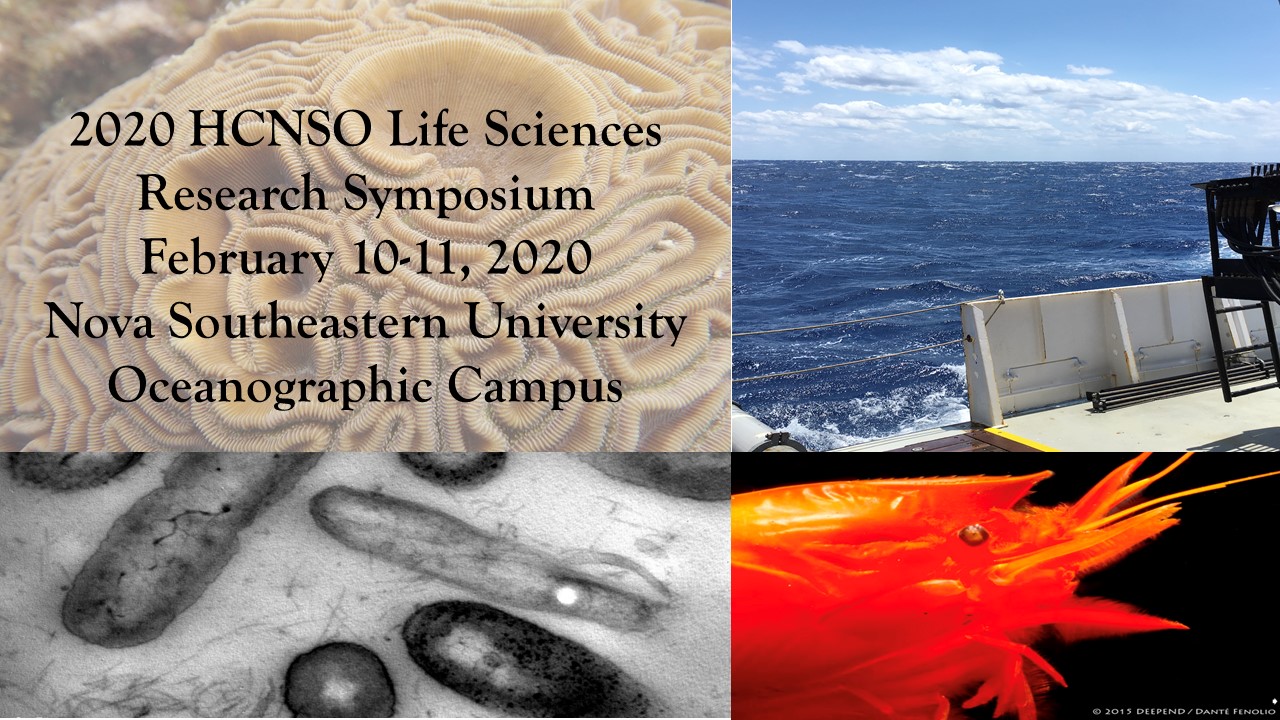Large corals and Interventions in a Coral Disease-Ravaged Area
Location
HCNSO Guy Harvey Oceanographic Center Nova Southeastern University
Start
2-10-2020 2:30 PM
End
2-10-2020 2:45 PM
Type of Presentation
Oral Presentation
Abstract
Large corals and Interventions in a Coral Disease-Ravaged Area
Brunelle, A.; Walker, B.K.
Nova Southeastern University, Halmos College of Natural Sciences and Oceanography
ab2991@mynsu.nova.edu
Coral diseases appear to be more devastating than ever before. When a virulent disease ravages a coral ecosystem, it can significantly change the population’s demographics and cause local extinctions. Disease intervention response during such an event is impossible at a landscape scale, therefore priorities must be considered. Saving the largest, oldest colonies of reef-building species is a good choice due to their high fecundity and ecological function. Their size, as a proxy for age, is an indicator of their resistance to previous perturbations which may indicate higher fitness. Their size also provides habitat to many organisms and wave resistance in shallow water for shoreline protection. Saving these colonies is imperative to preserve present ecological functions and to prepare for future restoration. We prioritized 90 of the largest, healthiest-looking colonies in southeast Florida during the SCTLD by remote sensing and ground truthing reconnaissance and ranking them by live tissue area, colony size, and number of tissue isolates. Colonies were checked for disease and photographed monthly. If diseased, intervention was conducted which entailed covering diseased tissue margins with chlorinated epoxy and sometimes creating a trench in the skeleton between diseased and healthy tissue and filling it with chlorinated epoxy. Treatment success generally went down over time and varied by treatment method and coral species. Methods were most effective on Orbicella faveolata (70%) and less effective on the limited number of treated Montastraea cavernosa (2.9%) colonies. Seven of the thirty-eight treated colonies did not respond favorably to intervention treatments. The number and length of new treatments varied monthly and was highest at the onset of rainy season and the warmest periods in late summer. After field-testing the effectiveness of antibiotic treatments, all treatments on the infected Large Corals were switched to amoxicillin ointment beginning in August 2019. This showed higher success for Orbicella faveolata (97%) and much higher success for Montastraea cavernosa (71.4%) colonies. The collection of gametes from large Orbicella faveolata colonies was attempted during the 2019 spawning season. While no spawning was observed in the field in August or September, bad weather inhibited all but one monitoring night in September. Though no gametes were collected in the field, several recently injured corals provided corals of opportunity to collect and rear in the lab.
Large corals and Interventions in a Coral Disease-Ravaged Area
HCNSO Guy Harvey Oceanographic Center Nova Southeastern University
Large corals and Interventions in a Coral Disease-Ravaged Area
Brunelle, A.; Walker, B.K.
Nova Southeastern University, Halmos College of Natural Sciences and Oceanography
ab2991@mynsu.nova.edu
Coral diseases appear to be more devastating than ever before. When a virulent disease ravages a coral ecosystem, it can significantly change the population’s demographics and cause local extinctions. Disease intervention response during such an event is impossible at a landscape scale, therefore priorities must be considered. Saving the largest, oldest colonies of reef-building species is a good choice due to their high fecundity and ecological function. Their size, as a proxy for age, is an indicator of their resistance to previous perturbations which may indicate higher fitness. Their size also provides habitat to many organisms and wave resistance in shallow water for shoreline protection. Saving these colonies is imperative to preserve present ecological functions and to prepare for future restoration. We prioritized 90 of the largest, healthiest-looking colonies in southeast Florida during the SCTLD by remote sensing and ground truthing reconnaissance and ranking them by live tissue area, colony size, and number of tissue isolates. Colonies were checked for disease and photographed monthly. If diseased, intervention was conducted which entailed covering diseased tissue margins with chlorinated epoxy and sometimes creating a trench in the skeleton between diseased and healthy tissue and filling it with chlorinated epoxy. Treatment success generally went down over time and varied by treatment method and coral species. Methods were most effective on Orbicella faveolata (70%) and less effective on the limited number of treated Montastraea cavernosa (2.9%) colonies. Seven of the thirty-eight treated colonies did not respond favorably to intervention treatments. The number and length of new treatments varied monthly and was highest at the onset of rainy season and the warmest periods in late summer. After field-testing the effectiveness of antibiotic treatments, all treatments on the infected Large Corals were switched to amoxicillin ointment beginning in August 2019. This showed higher success for Orbicella faveolata (97%) and much higher success for Montastraea cavernosa (71.4%) colonies. The collection of gametes from large Orbicella faveolata colonies was attempted during the 2019 spawning season. While no spawning was observed in the field in August or September, bad weather inhibited all but one monitoring night in September. Though no gametes were collected in the field, several recently injured corals provided corals of opportunity to collect and rear in the lab.


